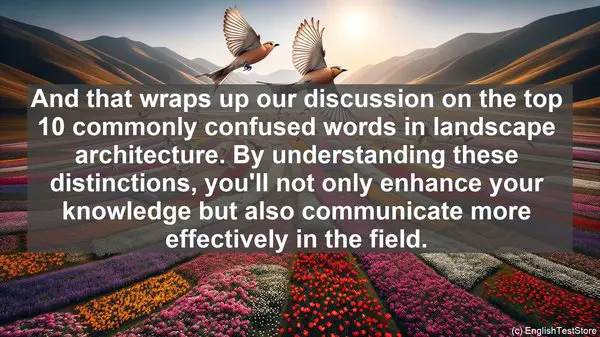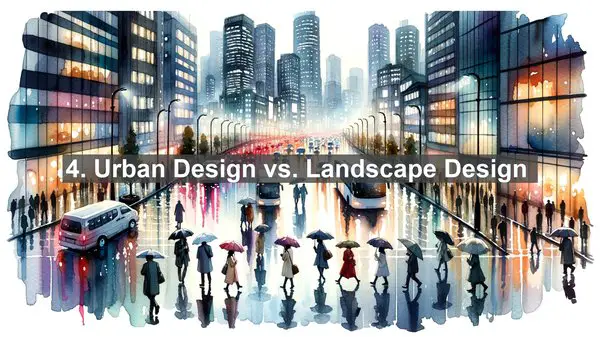Introduction
Welcome to today’s lesson on landscape architecture. In this lesson, we’ll be discussing the top 10 commonly confused words in this field. Understanding these words correctly is crucial for effective communication and professionalism. So, let’s dive in!
1. Hardscape vs. Softscape
The terms ‘hardscape’ and ‘softscape’ are often used interchangeably, but they have distinct meanings. Hardscape refers to the non-living, man-made elements like pathways, walls, and structures. On the other hand, softscape includes the living elements such as plants, trees, and soil. Remember, hardscape is about the solid, while softscape is about the natural.
2. Sustainability vs. Resilience
While both sustainability and resilience are important concepts in landscape architecture, they differ in focus. Sustainability is about minimizing environmental impact and resource use, ensuring long-term viability. Resilience, on the other hand, is about the ability to bounce back from disturbances, like natural disasters. Think of sustainability as long-term planning and resilience as preparedness for the unexpected.
3. Site Analysis vs. Site Assessment
Site analysis and site assessment are often used interchangeably, but they have different scopes. Site analysis involves studying the physical, environmental, and social aspects of a site. It’s about understanding the context. Site assessment, on the other hand, is more specific, focusing on evaluating the site’s suitability for a particular project. So, analysis is broader, while assessment is more targeted.
4. Urban Design vs. Landscape Design
Urban design and landscape design are closely related but have distinct focuses. Urban design deals with the planning and design of entire urban areas, considering factors like transportation, infrastructure, and public spaces. Landscape design, on the other hand, is about the detailed design of outdoor spaces, emphasizing aesthetics, functionality, and sustainability. Urban design is about the big picture, while landscape design is about the details.
5. Erosion vs. Sedimentation
Erosion and sedimentation are both processes that affect the land, but they differ in action. Erosion is the movement of soil or rock particles by wind, water, or other forces. It’s about the wearing away of the land. Sedimentation, on the other hand, is the deposition of eroded material, leading to the formation of sediment layers. So, erosion is about movement, while sedimentation is about deposition.
6. Permeable vs. Impermeable
Permeable and impermeable are terms used to describe the ability of a material to allow or prevent the passage of water. Permeable materials, like certain types of pavement, allow water to seep through, promoting natural drainage. Impermeable materials, on the other hand, like concrete, prevent water from seeping through, leading to runoff. So, permeable is about allowing water flow, while impermeable is about blocking it.
7. Xeriscaping vs. Zero-scaping
Xeriscaping and zero-scaping are both approaches to landscaping in arid regions, but they differ in philosophy. Xeriscaping involves using drought-tolerant plants, efficient irrigation, and water-conserving techniques. It’s about creating a sustainable, low-water landscape. Zero-scaping, on the other hand, emphasizes minimal water use, often relying on non-living elements like rocks and gravel. So, xeriscaping is about smart water use, while zero-scaping is about minimal water use.

8. Master Plan vs. Concept Plan
Master plan and concept plan are terms used in the planning stages of a project, but they have different levels of detail. A master plan is a comprehensive, long-term plan that outlines the overall vision, goals, and strategies. It’s like a roadmap for the entire project. A concept plan, on the other hand, is a preliminary plan that focuses on the basic layout and design ideas. It’s like a starting point for further development. So, master plan is about the big picture, while concept plan is about the initial ideas.
9. Biophilia vs. Biodiversity
Biophilia and biodiversity are related to the natural world, but they have different meanings. Biophilia is the innate human connection and affinity towards nature. It’s about the emotional and psychological bond with the natural environment. Biodiversity, on the other hand, refers to the variety of living organisms in a particular habitat or ecosystem. It’s about the richness and balance of life forms. So, biophilia is about the human-nature relationship, while biodiversity is about ecological variety.

10. Render vs. Sketch
In the visual representation of design ideas, render and sketch are two common techniques, each with its own purpose. A render is a highly detailed, realistic depiction, often created using computer software. It’s like a virtual image of the final design. A sketch, on the other hand, is a freehand drawing, usually quick and conceptual. It’s like a rough visual exploration. So, render is about precision, while sketch is about capturing the essence.
